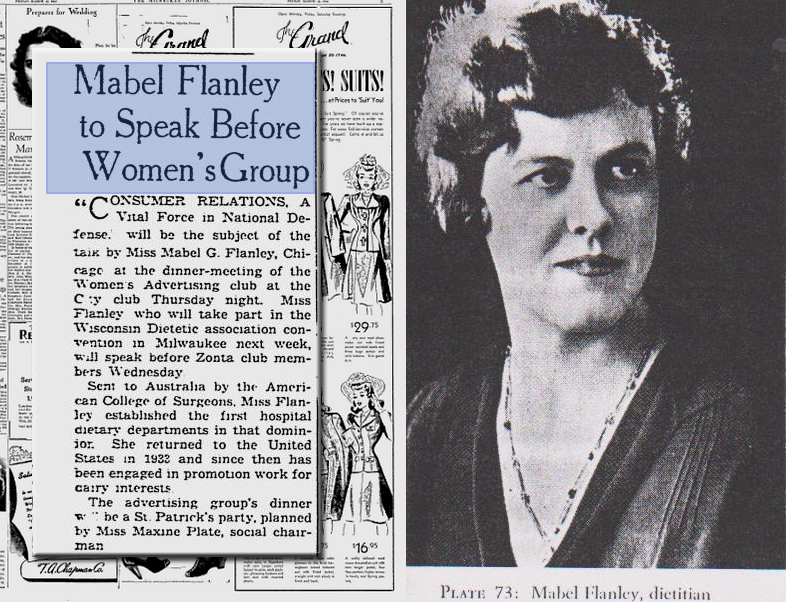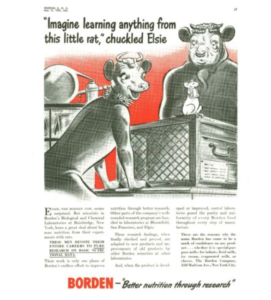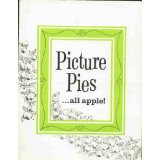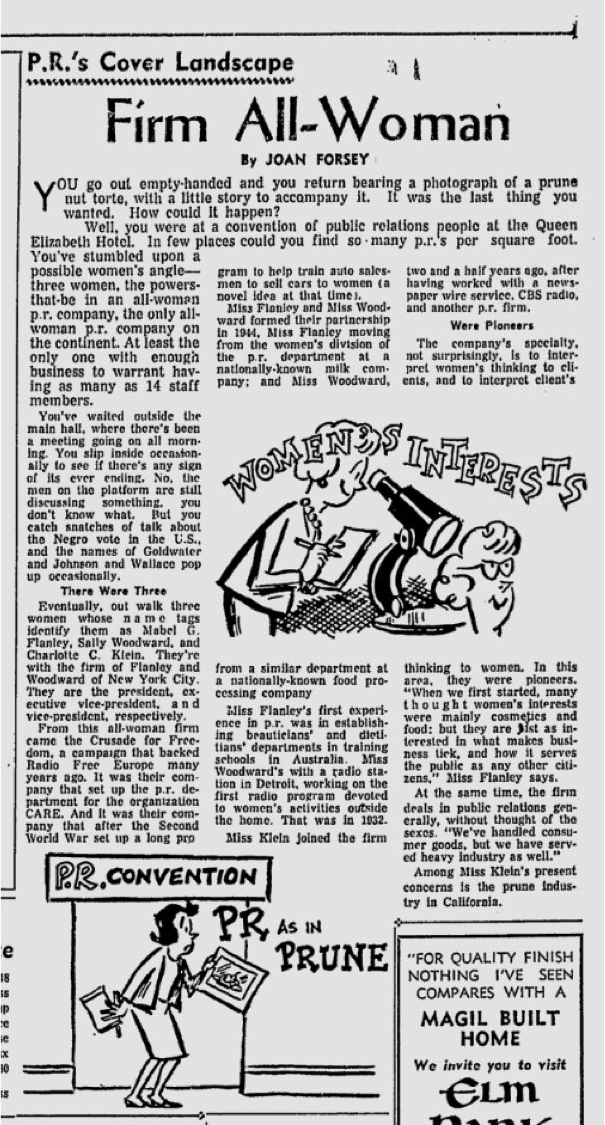
Late last year I received an email from Dr. Beverley Wood in Victoria, Australia about Mabel Gertrude Flanley in respect of reference to Mabel in a comment I’d made on a blog post in May 2014. Beverley was researching Mabel for an historical presentation at the Annual Conference of the Dietitians Association of Australia in May, and had a gap in her knowledge after Mabel’s return to the US in 1932.
Beverley told me “There were at least four American Dietitians who came out to Melbourne and Sydney to assist in the commencement of the profession of Dietetics here – Mabel Flanley, Edith Tilton, Ruth Gordon (Kansas) and Evelyn Anderson were at the very beginning. Mabel was the first in 1930 – Melbourne, the others went to Sydney, say 1936 etc. They were incredible women and I am very interested in them and their contribution to this country.”
As two females connecting across the planet to correspond about a pioneering woman who linked both our professions, I decided to look at the chapter that Mabel authored in the 1948 text: Your Public Relations that we are serialising here, to acknowledge International Women’s Day 2016.
Beverley kindly shared with me the photograph of Mabel, which I’ve supplemented with a newspaper report of her work. In turn, I produced a scan of the the book chapter, which I make available here as a pdf. Apologies for the poor quality scan, but for once, I’m going to let the chapter speak for itself and instead focus more on Mabel Flanley.
I’m taking this chapter out of order but will infill with future posts. We are now in Part V (How to Reach Special Publics) with thirteen chapters covered and a further twenty to come. Chapter XVI looks at The Women Publics and the authors’ biography section states Mabel G Flanley was Partner, Flanley and Woodward, Public Relations Counsel.
The firm specializing in “The Woman’s Angle”, serves corporations in widely divergent fields.
I like that Mabel came to public relations as an expert in her field. Before setting up, what was reportedly the first all women PR firm in New York in 1944 with Sally Woodward (formerly director of consumer and education relations for General Mills in Minneapolis where Harry A Bullis, author of chapter 2, was chairman of the board), Mabel worked at Borden Milk Products Co., New York City.
In a report in The Billboard noting the pair had set up “Fem Flackery” (short-hand one presumes for a PR firm!), Sally Woodward is noted as having inaugurated “commercial radio’s soap operas”.

I’m not sure if Mabel played a part in the creation of the Elsie the cow icon that still adorns Borden Milk products and was first introduced in 1937 – “extolling the virtue of milk in medical journals“. She is quoted in The Stanford Daily in 1940 as speaking in her role at Borden about the virtues of consumer co-operatives and advocating for “truthful advertising, correct labelling, and money spent for the education of the public” In 1941, she was eastern director of consumer relations at the company, and elected vice-president of the National Advertising Federation of America, so I don’t think I’m making a gigantic leap in making this suggestion.
Speaking at the Women’s Advertising Club of Milwaukee in 1941, Mabel is cited in the local newspaper as “urging her audience to act as interpreters between business and consumers” ahead of attending the Wisconsin Dietetic convention.
In 1942, Mabel was one of thirteen women seconded to the Government to lead a salvage campaign among housewives.
This goes beyond the usual narrative of employing women communicators to reach women consumers:
Flanley and Woodward note that hiring a woman to lead a woman’s program is necessary, but it is not enough in and of itself. They add four qualifications for such a woman: that she be well trained in a broad range of public relations activities, that she be well acquainted not just with women’s issues but with women opinion leaders, that she be familiar with business and how to work with management, and that she have respect for the organization by which she is employed. They stress that just having writing skills and employing one-way communication is not enough: these women must be involved in management decision making and employ two-way communications with publics-advice eerily prescient of contemporary public relations management theory.
 The firm was still in business in the late 1950s recruiting Jean Burtis in 1959. Mabel was then also executive director of the Processed Apples Institute, which appears to have been set up in 1951 as an initiative to boost sales of apple sauce, juice and slices. This is reported to have been a huge success in generating newspaper and radio coverage, changing cooking habits and increasing use of apple products by restaurants, schools and other institutions. A book: Picture Pies… All Apple was published by Flanley and Woodward in 1963.
The firm was still in business in the late 1950s recruiting Jean Burtis in 1959. Mabel was then also executive director of the Processed Apples Institute, which appears to have been set up in 1951 as an initiative to boost sales of apple sauce, juice and slices. This is reported to have been a huge success in generating newspaper and radio coverage, changing cooking habits and increasing use of apple products by restaurants, schools and other institutions. A book: Picture Pies… All Apple was published by Flanley and Woodward in 1963.
I found a fabulous article (see below) in the Montreal Gazette of November 11, 1964 by Joan Forsey reporting Flanley and Woodward employed 14 staff members and was still the “only all woman p.r. company on the continent”.
The quote from Mabel Flanley is that women are “just as interested in what makes business tick, and how it serves the public as any other citizens”.
This article references Charlotte C Klein as a recent employee of Flanley and Woodward. Charlotte was inducted last year into the PR Museum Women’s Hall of Fame.
Fittingly, Klein created the Women’s Hall of Fame in New York whilst employed at Flanley and Woodward – and there’s a great article about her on the Institute for PR site – it states she was fired by the agency for wanting to recruit a man to the team.
I’m not sure what happened next in the story of Mabel Flanley who seems to have been remarkable woman, but I think she died on November 7, 1994 at the age of 94.
I do hope this post stimulates further correspondence on Mabel Flanley, Sally Woodward, Charlotte Klein and this pioneering women’s PR firm. Their story would surely make a fabulous case study and is a timely reminder of the long history of women in public relations.

